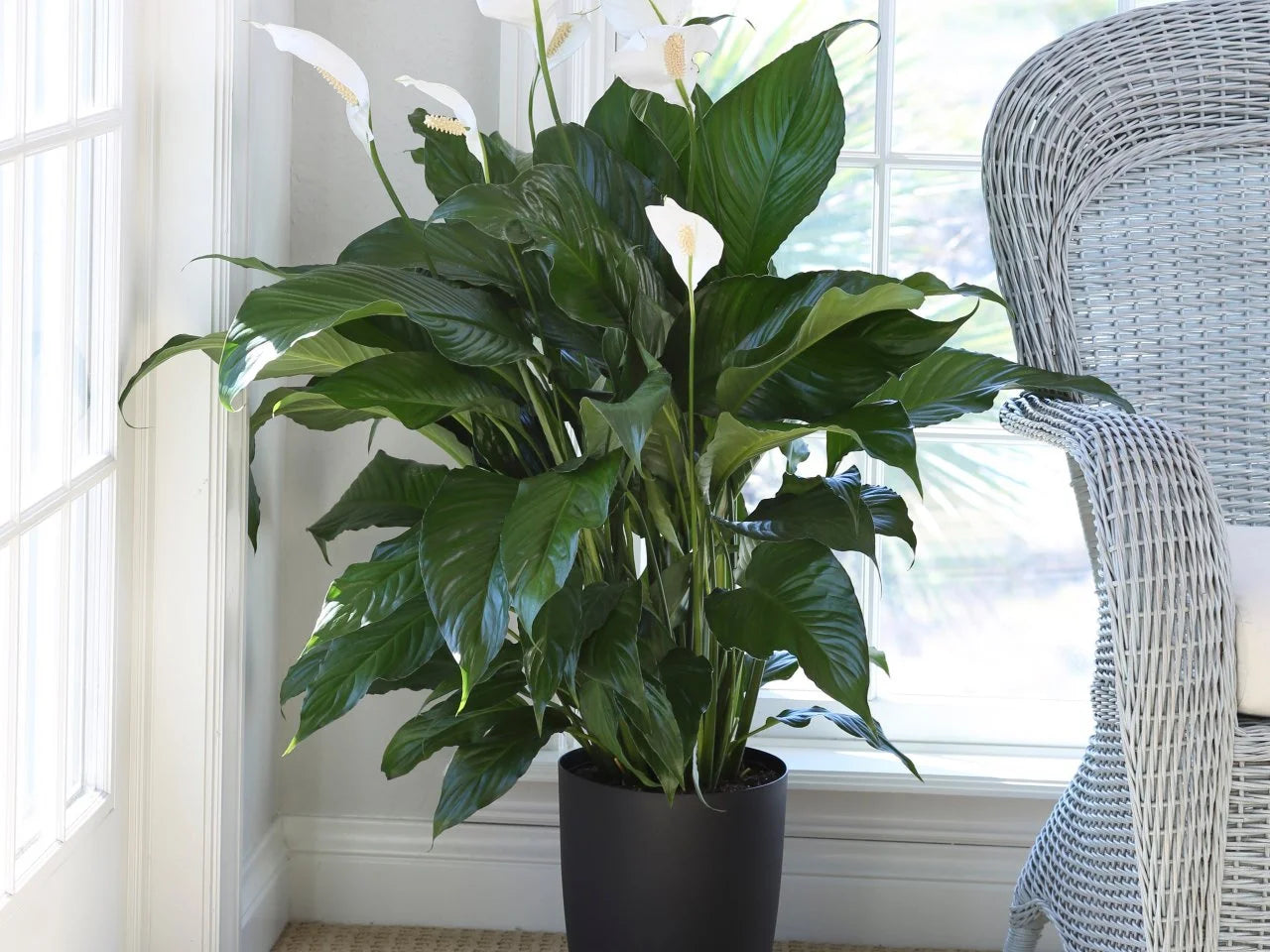Peace Lilies (Spathiphyllum), known for their striking white flowers and lush green leaves, are popular indoor plants that add elegance and tranquility to any space. Their beautiful blooms can last for several weeks, but once they fade, many plant owners wonder how to care for their Peace Lily to encourage new flowers. Proper post-bloom care is essential to keep your Peace Lily healthy and to promote future blooms. In this article, we’ll explore the steps you can take to care for your Peace Lily after flowering and encourage it to bloom again.

Understanding the Peace Lily’s Blooming Cycle
Before diving into the care tips, it’s helpful to understand the natural blooming cycle of a Peace Lily. Typically, a Peace Lily blooms twice a year, often in the spring and late summer. Each bloom can last several weeks before fading, and during this time, the plant requires specific care to ensure it remains healthy and continues to produce flowers.
Once the flowers begin to fade and turn brown, it’s a sign that the blooming phase is ending. At this point, your Peace Lily will enter a rest period, during which it will focus on leaf growth and recovery before the next blooming cycle.
Also Read- The Benefits Of Using Rainwater For Your Peace Lily
1. Pruning Spent Blooms
One of the first steps in caring for a Peace Lily after flowering is to remove the spent blooms. This process, known as deadheading, helps the plant conserve energy and encourages it to focus on new growth.
How to Deadhead a Peace Lily:
- Wait Until the Flowers Fade: Allow the flowers to naturally fade and turn brown. This ensures the plant has fully completed its blooming cycle.
- Use Clean, Sharp Shears: Use a pair of clean, sharp pruning shears or scissors to prevent damaging the plant. Dirty tools can introduce bacteria or pests.
- Cut at the Base: Cut the flower stalk as close to the base of the plant as possible, just above the soil line. Be careful not to damage the surrounding leaves.
Removing the spent blooms not only improves the plant’s appearance but also prevents the plant from wasting energy on maintaining dead flowers.
2. Adjusting Watering Practices

After your Peace Lily has finished blooming, its water needs may change slightly. During the blooming phase, the plant often requires more water, but after flowering, it’s important to adjust your watering routine to match the plant’s new needs.
Watering Tips After Flowering:
- Maintain Moist Soil: Peace Lilies prefer consistently moist soil, but not waterlogged. Allow the top inch of soil to dry out between waterings to avoid root rot.
- Reduce Frequency Slightly: As the plant enters its rest period, you may need to reduce the frequency of watering slightly. Monitor the soil moisture and adjust as needed.
- Avoid Overwatering: Overwatering is a common mistake that can lead to root rot. Ensure the pot has good drainage and remove any excess water from the saucer after watering.
Proper watering is crucial to keeping your Peace Lily healthy and preparing it for the next blooming cycle.
Also Read- How To Prune Your Peace Lily For Better Growth
3. Fertilizing for Future Blooms
Fertilizing your Peace Lily after it has finished flowering is essential to support new growth and encourage future blooms. However, the timing and type of fertilizer are important factors to consider.
Fertilizing Tips:
- Use a Balanced Fertilizer: Choose a balanced, water-soluble fertilizer with equal parts nitrogen, phosphorus, and potassium (such as 10-10-10). This will support overall plant health and blooming.
- Fertilize Monthly: During the growing season (spring and summer), fertilize your Peace Lily once a month. In the fall and winter, reduce fertilization to every 6-8 weeks or stop altogether, as the plant’s growth slows down.
- Avoid Over-Fertilizing: Over-fertilizing can harm your Peace Lily and may lead to salt buildup in the soil, which can cause leaf burn. Always follow the manufacturer’s instructions and consider using a diluted solution.
Regular fertilization provides the nutrients your Peace Lily needs to produce vibrant, healthy blooms.
4. Providing the Right Light Conditions

Light is a crucial factor in encouraging a Peace Lily to bloom. These plants thrive in bright, indirect light, but they can also tolerate low light conditions. However, for optimal blooming, adjusting the light conditions after flowering can make a significant difference.
Light Requirements After Flowering:
- Bright, Indirect Light: Place your Peace Lily in a location where it receives bright, indirect sunlight. Too much direct sunlight can scorch the leaves, while too little light can prevent blooming.
- Rotate the Plant: To ensure even growth, rotate the plant every few weeks so that all sides receive equal light.
- Artificial Light: If your home has limited natural light, consider using artificial grow lights to supplement the light your Peace Lily receives.
Ensuring your Peace Lily gets the right amount of light will help it build up the energy needed for the next blooming cycle.
Also Read- Why Every Home Should Have Peace lily
5. Repotting and Soil Care
Repotting your Peace Lily after it has finished flowering can refresh the soil and give the roots more room to grow, which can promote healthier growth and more abundant blooms.
When and How to Repot:
- Repot Every 1-2 Years: Peace Lilies typically need to be repotted every 1-2 years or when they become root-bound (when the roots fill the pot).
- Choose the Right Soil: Use a well-draining potting mix, such as a blend of peat, perlite, and pine bark. This provides the ideal balance of moisture retention and drainage.
- Select a Slightly Larger Pot: Choose a pot that is 1-2 inches larger in diameter than the current one. This gives the roots more space to grow without overwhelming the plant.
Repotting not only revitalizes the plant but also reduces the risk of root rot and other soil-related issues.
6. Maintaining Ideal Temperature and Humidity

Peace Lilies are tropical plants that thrive in warm, humid environments. Maintaining the right temperature and humidity levels after flowering is essential to keeping your plant healthy and encouraging new blooms.
Temperature and Humidity Tips:
- Keep Temperatures Consistent: Peace Lilies prefer temperatures between 65°F and 80°F (18°C to 27°C). Avoid placing the plant near drafts, air conditioners, or heaters.
- Increase Humidity: These plants thrive in humidity levels of 50% or higher. If your home is dry, consider using a humidifier, misting the leaves regularly, or placing the pot on a tray filled with water and pebbles.
Consistent temperature and humidity levels create an environment where your Peace Lily can flourish and bloom again.
Conclusion
Caring for a Peace Lily after flowering is crucial to encouraging new blooms and maintaining the overall health of the plant. By following these tips—pruning spent blooms, adjusting watering practices, fertilizing properly, providing the right light conditions, repotting when necessary, and maintaining ideal temperature and humidity—you can ensure that your Peace Lily continues to thrive and produce beautiful flowers for years to come. With the right care, your Peace Lily will not only be a stunning addition to your home but also a source of joy and tranquility.













Leave a comment
This site is protected by hCaptcha and the hCaptcha Privacy Policy and Terms of Service apply.